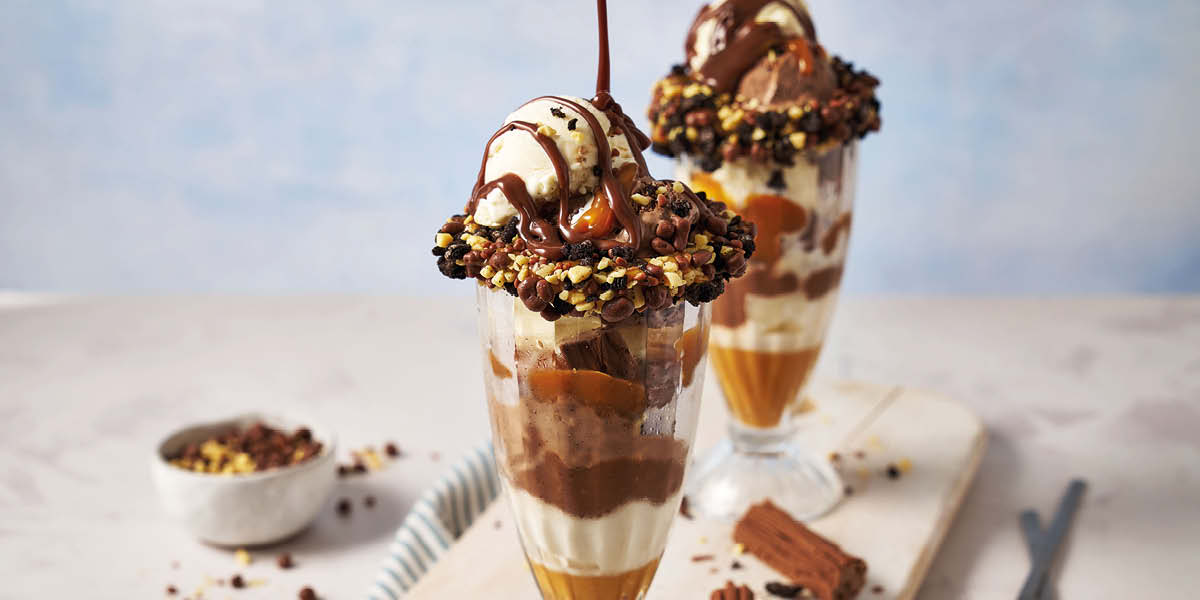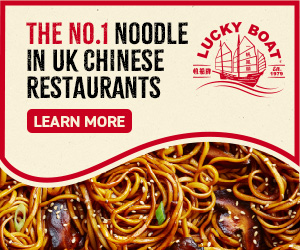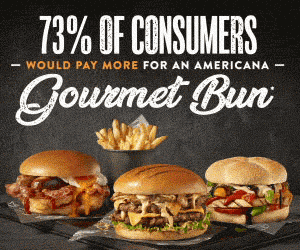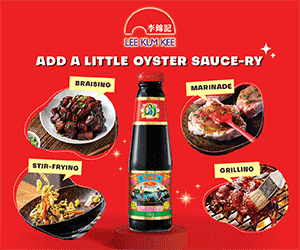Feature: Just desserts

No meal is complete without a soul-pleasing pud, so put together a varied and inclusive offering and watch the orders roll in!
There’s always room for dessert! No, seriously – there is always room for dessert, and there’s a scientific explanation to prove it. It’s called ‘sensory specific satiety’, which literally means getting full (or satiated) from a particular taste, texture or food combination. Our bodies tire of eating the same old grub, which results in us feeling full. But when a brand-new sensory stimulation arrives – like a gooey choccy pudding, for example – a chemical jolt sent to the brain’s reward centre sparks a real craving to try it, leading to pleasurable feelings when we eat, even if we thought we were stuffed prior to the pudding’s arrival.
“Variety is the spice of life – or should I say, the sweetness of life!” cheers Karen Green, marketing manager at Aimia Foods. “This is especially true when it comes to desserts. One or two mediocre options are unlikely to tempt customers to go for that final course. The options need to be varied, tasty and on-trend to appeal to the masses.”
And with 45% of diners keen to order desserts when eating out-of-home, the category marks a valuable profit-boosting opportunity for restaurant operators.
Trending treats
To capture guests’ attention, home in on creating high-quality sweet treats made with ingredients that are not only premium, but on trend.
“The popularity of chocolate brands, for instance, has continued in the cake industry, with 35% of consumers choosing one cake over another based on it being chocolate branded,” says Rebecca Calveley, trade marketing manager at La Lorraine Bakery Group, which owns the Panesco and Donut Worry Be Happy brands. “This highlights an opportunity for businesses to explore new cake ranges – which could lead to an increase in sales.
“The latest Mintel report also found that 47% of consumers who ordered cake or sweet baked goods bought them for a dessert after lunch or dinner, so emphasising the dessert qualities of cake could help them maximise sales,” she adds. Vini Stringhini, away-from-home customer category manager at Mondelez, agrees, claiming that tapping into brand influence is an easy way for operators to increase footfall and further profits. “Customisation remains a key trend that operators can take advantage of and is made easy with a little help from well-known products,” he suggests. “Allow guests to ‘build their own’ dessert, such as a sundae, with their favourite branded treats for a standout pudding on your menu.”
A major trend shaping the category today (along with the majority of segments in food-focused industries) is the growing appetite for all things plant-based. “I can see plant-based desserts continuing to grow,” says Greg Lambert, food director of SIX Rooftop, a restaurant and bar in Gateshead, Newcastle. “All of our puddings and petit fours are now plant-based and we have witnessed the benefits of this approach – which we’ll certainly be continuing. We love a challenge!”
SIX offers two separate tasting menus, one being land- and sea-based, and the other entirely plant-based. “Within these two menus, we can pretty much cater for most dietary requirements, including vegans and coeliacs,” Lambert points out. “We embrace the need for this type of offering – it spurs us on to be creative in our approach.”
The team at Hithe + Seek, a bar and kitchen located in the City of London, have also recognised the rising demand for inclusive eats, offering an extensive range of non-dairy and free-from options. “We use products that cater for those needs and make sure guests feel welcome throughout the day,” says the restaurant’s general manager, Bruno Castro. “We’re happy to adjust dishes and drinks for all guests with specific requirements and allergies.”
Conscious indulgence
Another influential factor impacting hospitality and related sectors is the rise of conscious eating. In a recent study by McKinsey & Co, almost half of consumers surveyed across all age groups and demographics cited healthy eating as a personal top priority. While the terms ‘dessert’ and ‘health’ may seem to contradict each other, there is a way operators can more effectively cater to those who are calorie counting.
“In some cases, customers may decide that, since they’re treating themselves anyway, they may as well go all out,” says Tom Styman-Heighton, development chef at Funnybones Foodservice. “On the flip side, some may feel they’ve already splurged enough on the main course, and therefore opt out of the sweet treat.
“To increase sales, operators have to make it worthwhile for the latter group,” he adds. “Sharing desserts, dessert boards and new and exciting products are all great ways to achieve this. Sharers are simple – just add a note to menus suggesting two spoons. If you don’t necessarily want to highlight this option, instruct front-of-house staff to suggest this to diners on the fence when ordering, as one dessert sold is better than none.”
For a light dessert, team up macarons with fruit, coulis and a dollop of cream to tempt customers with smaller appetites. “Macarons are the queens of sweet pâtisserie and lend themselves to so many occasions,” says Marie Emmanuelle Chessé, international development project manager at Tipiak.
“You can top shakes and ice cream with a macaron or two to create a special treat for customers. Equally, they can be used to decorate desserts or served on their own with other mini treats for a lighter pudding. With so many flavours and colours available, there’s bound to be something to suit the occasion.”
Edward Miles, managing director at Frank Dale, shares similar insights, highlighting the potential of bite-sized dessert classics for those who are mindful of health. “Large portions can sometimes be overwhelming but mini versions of traditional favourites work really well as desserts,” he posits. “Team with a small portion of seasonal fruit and a scoop of ice cream to create a summery treat.”
While the team at SIX have acknowledged the growth of conscious eating styles, the venue’s status as a special occasion restaurant means it doesn’t necessarily play out the same way as it would with other brands. “People come to us for birthdays, anniversaries, dates, business lunches or treats, so we don’t have too much pressure from customers asking for super-healthy options,” Lambert notes.
“But as health and wellbeing are important, we always keep one eye on balance and ensure our guests don’t go away feeling bloated and uncomfortable.”
Dessert delivery
Another valuable stream presented by the category lies in the potential for takeaway and delivery (more on this from page 30). Some desserts travel better than others, so opt for something you know won’t ‘deconstruct’ en route.

Freakshake featuring KaterBake mini donuts (Image: Central Foods)
“Donuts and hot apple pies are traditional favourites for takeaway and delivery sweet treats,” says Gordon Lauder, MD of Central Foods. “They’re popular products on any menu but they also have the advantage of being easy to transport – whether that’s by a delivery operator or a customer taking them home.”
A dish to remember
To give orders another boost, front-of-house teams can be encouraged to upsell puds by recommending favourites, and operators can consider putting on a ‘dessert of the day’ promotion to maximise sales of profitable items.
“Really focus on presentation – a classic dessert can be given the wow factor very simply, by upgrading the serving vessel and adding some finishing touches,” says Joanne Wyke, brand manager for foodservice at Premier Foods. “It also creates a classic sense of envy in other diners which, in turn, drives orders.”
Beautiful pâtisserie enables chefs to create amazing displays they can showcase through photos on their menus. “The versatility and prettiness of pâtisserie is unbeatable, from éclairs and macarons to filled tartelettes and delicious entremets,” notes Matthew Grenter, sales manager at Symphonie Pasquier. “And with most hospitality venues offering some sort of dessert, operators have to find new ways to tempt customers into a purchase.”
As the (most likely) last thing customers tuck into from your menu, you best ensure you pull out all the stops to make it one they won’t forget. At Hithe + Seek, the use of locally sourced and house-made ingredients ensures the brand’s sweet treats stand out. “Guests like to have a dessert with an after-dinner drink, and our biggest seller is the Strawberries & Cream Baileys Baked Cheesecake,” says Castro. “We also produce coffee- and tea-infused desserts. Coffee cake is a classic, while latte, mocha, chai, matcha and Earl Grey flavoured cakes and ice creams are gaining more popularity this year.”
The SIX crew also focus on British seasonal ingredients and elevated presentation. “This is always at the core of our development and production,” Lambert states. “By doing this, we have traceability of produce, and guarantee maximum flavour from the ingredients as they are used in their prime.
“We offer set tasting menus, so everyone gets to enjoy a dessert and petit fours afterwards,” he concludes. “But we spend a lot of time on our dessert as it’s the course that leaves the lasting impression.
“We like to impress, making sure there are some fun, balanced flavours, a bit of naughtiness and plenty of texture.”
Lead image: Triple chocolate sundae with Flake and Oreo, Mondelez















